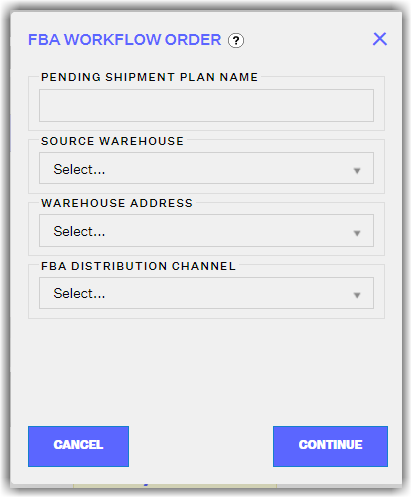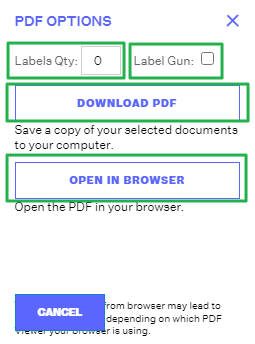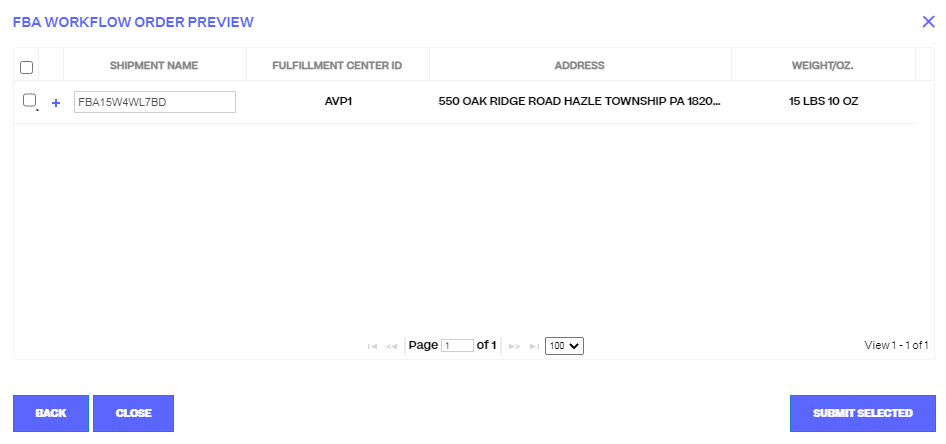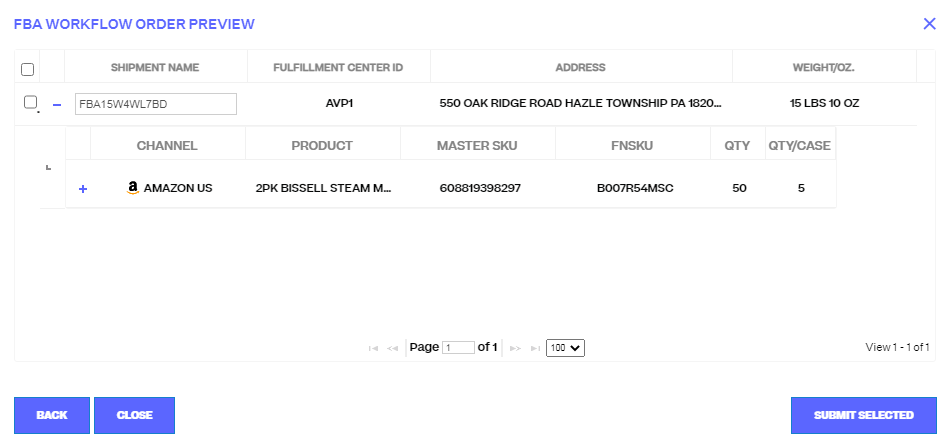-
Order Management
- Dashboard
-
Orders
- Amazon FBA: Common Errors and Troubleshooting
- Orderbot: Split Order by Available Stock
- DHL eCommerce Integration Specifics
- Shipping Orders - Processing Options
- Bulk Actions for Orders
- Custom Fields for Orders (Custom Columns)
- UPS Electronic Customs Documents - ETD & Commercial Invoices
- Multi-Channel Fulfillment
- Duplicate or Clone an Order
- FBA Workflow Box Contents & Secondary "Ship From" Address
- Box Contents Defaults for FBA Workflows
- Customizing the organization of Columns in the Orders Module
- Missing Stock Location and Configuring Inventory
- Downloading and Printing Pick Lists
- FBA Order Management
- Resolving an Order in Missing Product Information Status
- Restoring a Cancelled Order
- Reprinting Shipping Labels
- Importing External Shipments
- Stock Transfers
- Canceling an Order
- Restore an On-Hold Order
- Shipping an Order with Multiple Packages
- Creating and Receiving an RMA
- Creating a Manual Order
- Resolving Out of Stock Orders
- Downloading and Printing Packing Slips
- Creating a Manual Order - Individually or In Bulk
- Manually Mark an Order as Shipped - Individually or in Bulk
- Can I create an RMA for an FBA order?
- Export an Order to a 3PL
- Resolving an order that is "Missing Fulfillment Source"
- Ship Multiple-Package Orders
- Fulfilling an order using MCF (Multi-Channel Fulfillment) for a Core Product in a Bundle
- Validating Shipping Addresses
- Updating Orders in Bulk
- Unresolved: Missing Order Info
- Changing Fulfillment Method and Source
- Importing Orders Via Spreadsheet (In Bulk)
- Resolving an Awaiting Payment Order
- Importing Tracking Information for Shipped Orders via a Spreadsheet
- Changing an Order to Amazon Multi-Channel Fulfillment (MCF)
- Customs
- Shipping Orders
- Merging Orders in Order Manager
- Splitting Orders in Order Manager
- Exporting Orders
- Searching and Filtering Orders
- Extensiv Order Manager Workflow for Sending Dropship Orders via Email
- Resolving Missing Product Info Orders
- How to add an item to an existing order
- Unresolved: Missing Fulfillment Source
- What does the error "Weight cannot be less than the total customs item weight" mean?
- Update about Accessing Orders
- Pre-order/Back Order Workflow
- Updates to FBA Integration with Order Management
-
Inventory
- Viewing Stock Edit History
- Strict FIFO
- Bulk Inventory Reconciliation
- Stock Location - Inventory Management Functionality
- Stock Edit History Export
- Inventory - Transfers Tab
- Inventory - How Extensiv Order Manager Presents Bundle Inventory
- Inventory Update Triggers
- Exporting Stock Details
- Exporting Inventory
- Importing Reorder Rules
- Inventory Rules - Edit History
- Inventory Rules per Master SKU
- Uploading Auto-Reorder Rules in Bulk
- Excluding Warehouse's Stock at the SKU Level
- Channel Allocation Rules in Bulk (Global)
- Creating Auto-Reorder Rules
- Channel Allocation Rules
- How to Search for SKUs in the Inventory Module
- Uploading Inventory via Spreadsheet
- Manually Transferring Stock to Another Location
- Inventory Module Overview
- Inventory Value Reconciliation
- Excluding a Warehouse from Showing Stock for all Products in Bulk
- Importing Stock Minimums
- Incoming Units per Master SKU
- Importing Inventory
- Uploading Inventory Through the UI
- Adding Inventory to a Stock Location Manually
- How to Filter Inventory by Warehouse
-
Purchase Orders
- Available Actions for a PO
- Restoring a PO
- Updating PO Number Prefix
- Re-Sending a PO
- Receiving a P.O.
- Printing a P.O.
- Canceling a P.O.
- Authorizing a P.O.
- Working with PO Milestones
- Voiding a P.O.
- Searching for POs
- Auto POs + Reorder Rules
- How to Create a Manual PO
- How to Automate Purchase Orders (Auto-POs)
- How can I delete a line item from a purchase order?
- Paste from CSV - PO Import
- Understanding Purchase Order (PO) Statuses
- Exporting POs
-
Shipments
- Searching for Shipments
- Printing Shipping Labels
- Printing End of Day Forms
- Tracking Shipments
- RMA Exports
- How do I print an End of Day form or Package Level Detail report for UPS shipments?
- Shipments - Resending Confirmation Emails
- Voiding Shipments
- Postal Zones
- Exporting Shipments
- Parcel API Launch for Extensiv Brands
- Customers
-
Products
- Instructional Video - Master Product Spreadsheet
- Exporting Products
- Product Creation FAQ
- Associating a Listing SKU to a Master SKU
- Creating Core Products in the App
- How to Manage Products
- How to Import Your Vendor Products
- Search For Products
- How to Reassign a Listing SKU to Another Product
- Creating Products through the UI
- Creating Listing SKUs in Bulk (via Spreadsheet)
- Creating Vendor Products in Bulk (Via Spreadsheet)
- How to Disable Inventory Updates for a Specific Sales Channel
- How to Enable Extensiv Order Manager to Automatically Calculate Order Weight Based on Product Weight
- How does Extensiv Order Manager handle variations of the same product?
- Adjusting Master SKUs
- Creating Vendor Products in the App
- Creating Product Variations Through the UI
- Creating Products via Spreadsheet
- Creating Listing SKUs through the UI
- Creating Bundles/Kits Through the UI
- Custom Bundle/Kit Export
- Custom Product Fields
- Managing Digital SKUs
- Analytics
-
Settings
-
General
- Tax Identifiers
- Company Time Zone Setting
- Ruby Has 3PL Integration
- Disable the Inventory Update From Extensiv Order Manager to All Sales Channels
- Update My Profile
- How to Enable Out of Stock Control for eBay Sales Channels
- Company Info and Additional Account Settings
- How to View Your Extensiv Order Manager Invoices
- Installing an App from the Order Manager App Store
- How To Remove an App in Order Manager
- Configuring Shipping Presets
-
Sales Channels
- Walmart Fulfillment Services - WFS
- Setting Up Shipment & Carrier Mappings for Your Sales Channels
- WFS Workflow
- Amazon Cancellation Settings
- Amazon Pacific Time Orderbot Setting
- Shopify Locations
- Shopify Tags
- Enable or Disable Extensiv Order Manager Email Notifications to Your Customers
- Deactivating a Sales Channel
- Adding Shopify as a Sales Channel
- Viewing a Sales Edit Channel's History
- Adding Amazon as a Sales Channel
- Adding eBay as a Sales Channel
- Adding Newegg as a Sales Channel
- Steps in Adding Walmart as a Sales Channel
- Editing Sales Channels
- Adding a Manual Sales Channel
- How to Exclude a Warehouse From Pushing Inventory to a Sales Channel
- Assigning a Packing Slip and/or Email Template to your Sales Channel
- Adding Sales Channels
- Reactivating Sales Channels
-
Webhooks
- Order Payment Webhook
- Shopify Auto-Subscribing Webhooks
- Shopify Product Update / Product Edit Webhook
- Shopify Refund Webhook (e-commerce Orders)
- Order Creation Webhook
- Shopify Cancellation Webhook
- Shopify Fulfillment Webhook
- Shopify Refund Webhook - POS Orders
- Shopify Product Deletion Webhook
- BigCommerce Webhook
-
Shipping Providers
- Adding Shipping Providers
- Adding DHL eCommerce as a Shipping Provider
- How to Add Express 1 as a Shipping Provider
- Adding Amazon Buy Shipping as a Shipping Provider
- UPS Mail Innovations Services
- Customizing Shipping Services and Package Types Per Shipping Provider
- FedEx ETD
- Deactivate or Reactivate a Shipping Provider
- Adding FedEx as a Shipping Provider
- Adding Stamps.com as a Shipping Provider
- Vendors
-
Warehouses & Vendors
- Instructional Video - Creating Warehouses & Warehouse Settings
- Use Component Inventory Setting for Bundles and Kits
- Setting a Dropship Template and Fulfilling Orders with a P.O.
- Configuring Dropship Vendor FTP
- Configuring Shipping Label Print Format Options
- Can I have additional order information populated on my Shipping label?
- Configuring a Dropship Vendor
- How to Configure the Order Export File for FTP Connections
- Search for Vendors
- Inventory Dependent Warehouses
- Updating the Address/Return Address for Your Warehouse
- Deactivating a Warehouse in Extensiv Order Management
- Creating and Configuring Warehouses in Extensiv Order Manager
- Pick List Settings
- Setting Up Document Print Settings
- Setting Up Domestic Backup Warehouses
- FTP Inventory Import for a 3PL
- Setting Up a Warehouse's International Rank
- How do I connect Extensiv Order Manager with Deliver?
- Setting Up a 3PL Warehouse
- Creating an In-House Warehouse
-
Orderbots
- Adding Order Item to Order Orderbot Action
- Understanding Apply Best Rate vs Cheapest Rate Orderbots
- Support for Shopify's Additional Details
- Orderbots filtered by zip code range
- Postal Zones in Extensiv Order Manager
- Mark Order as Shipped Orderbot
- Automating Orders to Fulfill from a Specific Warehouse
- Editing an Orderbot
- Deactivating an Orderbot in Extensiv Order Manager
- Replace Address Orderbot
- Creating an Orderbot
- Orderbots - Complete List of Filters & Actions
- Orderbot: Set order weight and dimensions based on products
- Orderbot: Using Hold the order for and Mark Order as Shipped
- Commonly Used Orderbots
- Templates
-
General
- API
- API Integrations
- Accessing and Navigating Order Manager
- Error Messages
-
Order Manager
- Customer Experience Upgrades
- Brexit for UK Inventory & Shipments
- BigCommerce Order Statuses
- Order Export Configuration in the UI- Complete List of Order Export Fields
- FBA to FBM Conversions - Amazon North America Remote Fulfillment with FBA Sellers
- Error Message “Invalid Customs Item Data”
- Integrating Endicia
- Error: "The Shippers shipper number cannot be used for the shipment"
- Edit Shopify Order Items
- Adding BigCommerce as a Sales Channel
- Where does Extensiv Order Manager determine Inventory Value and COGS from?
- Endicia's pay-on-use return labels?
- [FAQ] What other Amazon marketplaces do you integrate with?
- Does Order Manager Support Amazon Buy Shipping?
- Shopify POS Location Capture and Orderbot
- Formatting Order Information When Shipping to US Territories
- Enable Shopify POS
- Reactivating an Orderbot
- Setting Up Billing/Inventory Allocation Zones
- How To Set Up Shipments Import
- What are Orderbots?
- Addressing missing Snapshot Data on July 9, 2023
-
Popular Articles
- Viewing Stock Edit History
- Error: "The Shippers shipper number cannot be used for the shipment"
- Support for Shopify's Additional Details
- How to Manage Products
- Walmart Fulfillment Services - WFS
- Does Order Manager Support Amazon Buy Shipping?
- What are Orderbots?
- Understanding the Extensiv Order Manager Dashboard
- Amazon FBA: Common Errors and Troubleshooting
- Shopify Refund Webhook - POS Orders
- Accounting Integrations
FBA Workflow
As of March 1st, Order Manager shows an error when making changes to "Send to Amazon" workflow orders as a result of Amazon migrating API sellers to “Send to Amazon”. Kindly make sure not to view, or make changes to "Send to Amazon" workflow in Seller Central as it invalidates the API updates, and handle every change through the Order Manager.
This is not something within Extensiv's control, but rather is a decision made by Amazon.
Within Extensiv Order Manager, sellers have the ability to create Fulfillment by Amazon (FBA) Shipments without the hassle of doing it directly in Seller Central.
FBA Workflows are shipments created in Extensiv Order Manager for inventory to be sent from your warehouse source to Amazon's Distribution Centers in order to make that inventory available to sell under the FBA program.
To create your FBA workflow plan, click into the Orders Module. From there, you should click New Order. Once clicked, select FBA Workflow from the dropdown menu.

A new prompt will open and ask you to indicate a “Pending Shipment Plan Name”. This name will eventually be overwritten when you are ready to submit the plan over to Amazon. This interim name cannot contain special characters, including spaces.
The three dropdown menus will ask you to select the source warehouse, which is the warehouse that the inventory will be pulled from, a warehouse address, for which you have the warehouse's Basic Info address and any Secondary Addresses as options, and the third dropdown is the destination FBA channel (ie: Amazon US vs Amazon FR or CN).
At the top of the next window that appears, notice that both the source warehouse and the destination sales channel, which you previously selected on the first page, are displayed. You can also choose your preference, between you as the seller or Amazon.
Lastly, you also have the option to select Based on In-stock Days. Checking this option will tell Extensiv Order Manager to only calculate sales velocity based on the days you actually had inventory at FBA.

Below is a group of search and filter fields that will help customize the data you wish to see represented in the report below. Make sure to click the Apply Filters button after making any changes to the default values.
The filter options are:

From there, the next section displays columns with information on each product. All columns are sortable except for the “Available” column. The data points are:

Once you have checked off the SKU(s) you wish to send, click the Add button to add them to the bottom grid.

The bottom grid displays any items in the plan, along with the quantity being sent. This information is automatically pulled from the top report from the column “Qty. to Transfer” in addition to the “quantity per case”. Regarding the quantity per case, this is the total number of units that make up each case, not how many cases you are sending. Feel free to override the quantities suggested by Extensiv Order Manager.

If you wish to take an item out of the plan that you are working on, select the item(s) and click the “Remove” button.
Next to each product name is a small printer icon. This clickable icon will give you the ability to generate your product labels if you chose to do so from this window. There are many other places within Extensiv Order Manager where you can print your item labels as well.

If you click the printer icon, a new pop up will appear. This window will ask you to select the following:

You also have the ability to paste all of your FBA workflow data as CSV if you choose not to go through the list directly. You will need these required fields to complete a CSV paste:

From the “New FBA Workflow Order” window, you have two options to proceed with:

If you select “Next – Generate Preview” the following page will be similar to the window in Seller Central, where Amazon divides up your plan into separate shipments and chooses the address(es) to ship it/them off to. The fulfillment centers and addresses presented are set by Amazon's API and cannot be edited.
Within this window, you also have the option to override the more traditional “Shipment Name”, which has already replaced your original pending shipment plan name, with your own custom name.
NOTE
You cannot use the same shipment plan name more than once.
Within this window, if you click on the + sign next to each shipment, you will have more prep preferences to review and select.
Once satisfied with all aspects of your order, select “Submit Selected”. Once submitted, the order will be registered in Seller Central and the physical order in Extensiv Order Manager will move to the appropriate fulfillment source category (i.e. “Awaiting Shipment”, “Awaiting 3PL Export”, “Awaiting Dropship”).
For next steps, refer to the section for the status your order ends up in:
Awaiting Shipment: You can generate small parcel and LTL/FTL shipping labels in Extensiv Order Manager with Amazon Partnered Shipping. Once the labels are generated and the order is in a shipped status in Extensiv Order Manager, we will communicate the shipment data to Seller Central. If you are shipping an FBA Workflow with an alternate provider in your Extensiv Order Manager account, the box contents labels will need to be generated outside of Extensiv Order Manager. If you choose to ship the entire shipment externally, then the workflow will need to be manually marked as shipped with carrier and tracking information.
Awaiting 3PL Export: You can have the FBA Workflow shipped by your 3PL. Once shipped and the tracking information is communicated back to Extensiv Order Manager, we will update Seller Central.
Awaiting Dropship: You can have the FBA Workflow shipped by a dropship vendor. Once shipped and the tracking information is communicated back to Extensiv Order Manager, we will update Seller Central.
Alternatively, if you select Save & Close from the draft plan window, the shipment window will be closed out and the shipment will fall under the “Pending Shipment Plan” section in the Orders module. You can then re-visit your shipment and continue working on it from there.
NOTE
When an FBA Workflow is in Pending Shipment Plan status, it is not yet considered an "order" and will not show up in an orders search for the pending shipment plan number.
Under the “Pending Shipment Plan” section, you can select your order(s) via checkbox and a list of buttons will appear for you to take action on.
These buttons are:

Once the shipment is generated, you can then ship it or mark it as shipped in Extensiv Order Manager. You can track the movement of your shipment by going into the Inventory Module and selecting the “Transfers” tab near the top of the page.
Once Amazon receives the shipment, Extensiv Order Manager will automatically update the FBA warehouse quantities as soon as Amazon makes those quantities available via the API.





